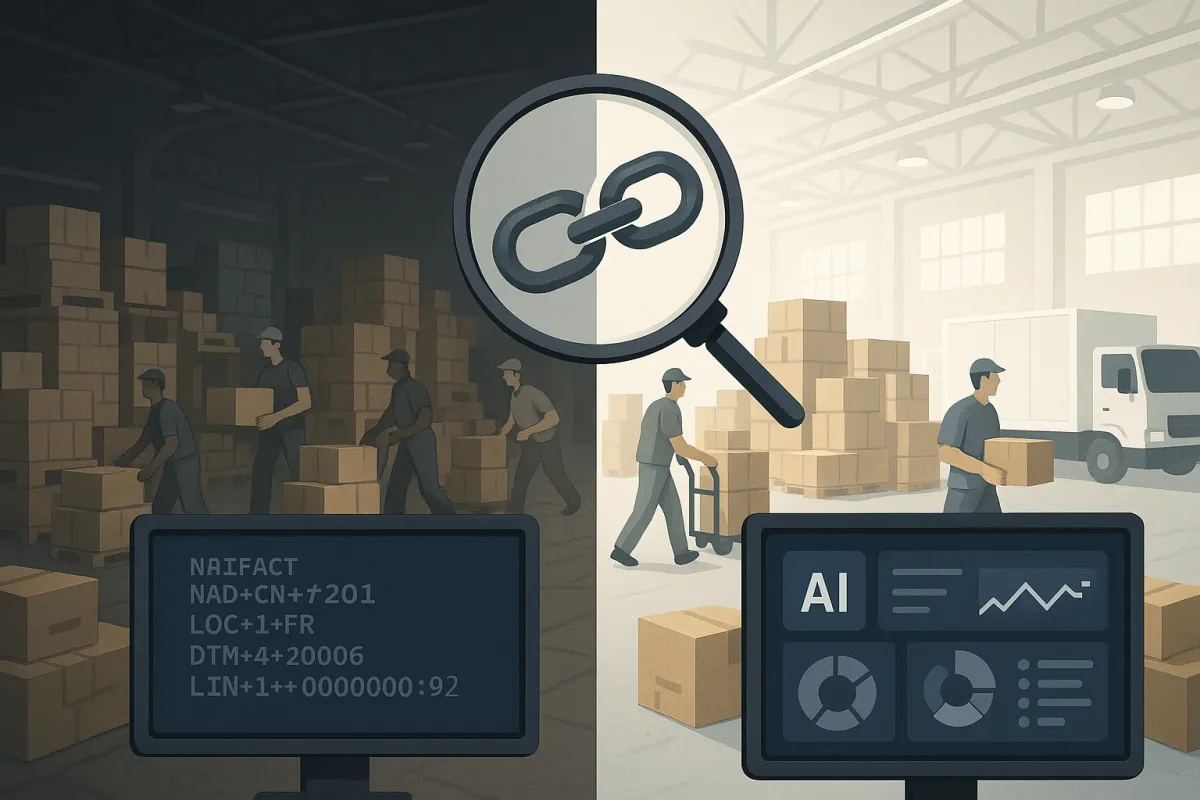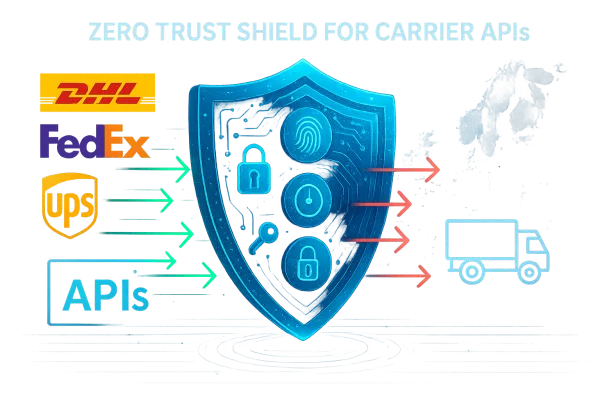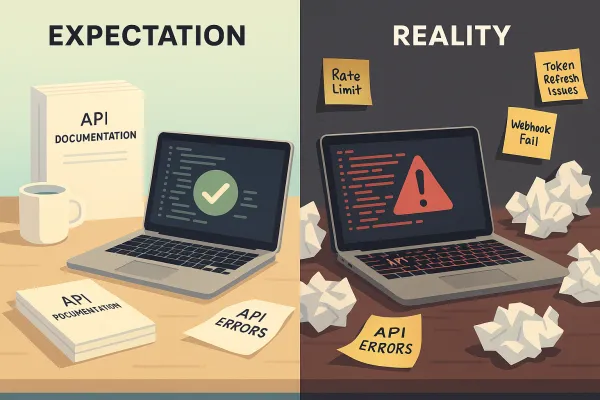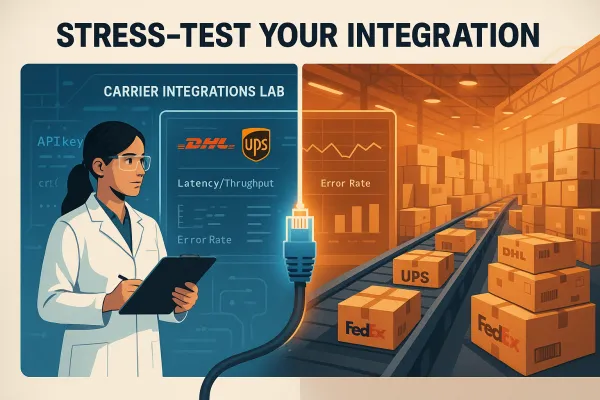AI-Powered Monitoring: The Missing Link in European Carrier Integration Security

API breaches jumped 80% year-over-year with 650,000 sensitive messages exposed in just one incident this January. Trello's exposed API compromised data from 15 million users, while Dell suffered a breach affecting 49 million customer records through API vulnerabilities. For European integration teams managing carrier connectivity, these numbers aren't just statistics—they represent a fundamental security crisis in transport APIs.
The scale of API security problems specifically impacts shipping and logistics operations across Europe. 68% of organizations experienced API security breaches costing over $1 million, and 95% have experienced security problems in production APIs. Yet only 7.5% of organizations have implemented dedicated API testing and threat modeling programs.
Why Traditional Security Fails for Transport APIs
European carrier integration security faces unique challenges that generic API security approaches simply can't address. EDIFACT is widely used across Europe, while FORTRAS format has become a standard for electronic data exchange between forwarding companies since 2001. These legacy systems create specific vulnerabilities that modern AI-powered monitoring needs to understand.
Paperless communication between customers, suppliers, manufacturers and freight forwarders relied on standards such as Fortras, ODETTE or EDIFACT, but the standardization that was once an advantage has become a disadvantage due to different industry and country requirements. Integration teams at companies using platforms like nShift, EasyPost, ShipEngine, and Cargoson must navigate this complexity while maintaining security.
File-based EDIFACT and FORTRAS exchanges create particular security blind spots. Unlike modern REST APIs with OAuth 2.0 flows, these systems often rely on FTP transfers or AS2 protocols with limited authentication mechanisms. Even smaller forwarders who may not have EDIFACT capabilities rely on FORTRAS EDI formats to integrate into the digital loop.
Rate limiting, one of the most basic API security controls, becomes meaningless in batch file transfers. Webhook validation—another security cornerstone—doesn't exist in asynchronous file processing. This leaves European integration teams vulnerable to attacks that traditional API security tools would catch immediately.
The AI Security Revolution: From Reactive to Predictive
The global AI in cybersecurity market was estimated at $25.35 billion in 2024 and is projected to reach $93.75 billion by 2030, growing at a CAGR of 24.4%. The AI cybersecurity market size is expected to reach $60.6 billion by 2028 from $22.4 billion in 2023. This explosive growth reflects the fundamental shift from reactive security patches to predictive threat detection.
AI-powered observability for end-to-end API performance and security monitoring, along with adaptive machine learning models for continuous API authentication risk scoring are reshaping how integration teams protect carrier connections. Instead of waiting for rate limits to trigger or logs to show suspicious patterns, AI systems can identify anomalies in API behavior patterns before they become breaches.
Pattern recognition algorithms can detect when a carrier's API starts returning unusual error rates, suggesting potential compromise or system instability. Behavioral analysis identifies when authentication tokens are being used from unexpected geographic locations or at unusual times. These insights become actionable within seconds, not hours or days.
AI/ML tool usage skyrocketed by 594.82%, rising from 521 million AI/ML-driven transactions in April 2023 to 3.1 billion monthly by January 2024. This surge in AI-powered API traffic creates both opportunities and challenges for carrier integration security.
European Regulatory Compliance Adds Complexity
European businesses face unique regulatory requirements that complicate AI-powered API security implementations. GDPR data residency requirements mean security monitoring systems must process sensitive shipping data within EU boundaries. Both carriers and border authorities act as "controllers" under GDPR regulation with respect to personal data they process.
The challenge intensifies with API storage limited to 48 hours from flight departure for certain transport operations, while security monitoring requires longer data retention for pattern analysis. This creates a tension between compliance and effective threat detection.
Explainable AI becomes mandatory when automated systems make decisions about blocking API calls or flagging suspicious behavior. European regulators increasingly require transparency in algorithmic decision-making, especially when it affects business operations. Integration teams need AI security tools that can provide clear audit trails showing why specific actions were taken.
Legacy System Integration Security Challenges
FORTRAS defines three message types: BORD (loading report), ENTL (unloading report), and STAT (status report), each with distinct security implications. Unlike modern APIs with standardized authentication flows, these legacy formats often rely on partner-specific implementations that vary significantly between carriers.
EDI relies on standardized data exchange formats that must be adhered to by all participants, but these standardized formats often prove inflexible and make adaptations to business processes difficult. This inflexibility extends to security implementations, where adding new authentication methods or monitoring capabilities requires extensive testing across multiple carrier relationships.
Building AI-Powered Monitoring for Carrier Integrations
Implementing AI-powered monitoring for European carrier integrations requires a multi-layered approach that addresses both modern APIs and legacy systems. Start with anomaly detection algorithms that learn normal traffic patterns for each carrier connection.
For REST APIs, implement real-time behavior analysis that examines request patterns, response times, and error rates. Set up machine learning models that understand seasonal shipping patterns—Christmas volume spikes shouldn't trigger false alarms, but unusual midweek traffic from a specific carrier endpoint should.
Legacy EDIFACT and FORTRAS monitoring requires different approaches. File-based exchanges need content analysis that examines message structure, sender patterns, and timing anomalies. AI models can detect when BORDERO messages contain unusual routing instructions or when ENTL reports show impossible delivery times.
Webhook validation becomes critical for modern carrier APIs. Implement automated signature verification and timestamp checking. AI systems can learn normal webhook delivery patterns and flag delayed or out-of-sequence notifications that might indicate man-in-the-middle attacks.
Authentication token monitoring deserves special attention. Track token usage patterns across geographic locations and time zones. European carriers often have predictable business hours—API calls at 3 AM from Munich-based DHL systems should trigger immediate investigation.
Measuring Success: KPIs for AI-Enhanced Security
Currently, 99% of organizations struggle to contain incidents relating to their APIs, and 22% have experienced breaches. These baseline metrics provide a starting point for measuring AI security improvements.
Focus on mean time to detection (MTTD) for anomalous API behavior. Pre-AI implementations typically detect threats in hours or days. AI-powered systems should achieve MTTD under 5 minutes for critical anomalies.
False positive rates matter enormously in carrier integrations. Blocking a legitimate DHL API call costs immediate business impact. Target false positive rates below 2% while maintaining detection accuracy above 95% for known attack patterns.
Track coverage improvements across your carrier ecosystem. Only 15% of organizations are highly confident in their ability to identify which APIs expose PII data. AI monitoring should provide complete visibility into data exposure across all carrier connections.
Monitor compliance metrics specific to European requirements. Track GDPR data residency compliance, audit trail completeness, and explainability metrics for automated security decisions. These regulatory KPIs become increasingly important as enforcement intensifies.
The Future: Self-Healing Carrier Integrations
By 2028, the use of multi-agent AI in threat detection and incident response will increase from 5% to 70% of AI applications. This evolution points toward self-defending APIs that can automatically adapt to emerging threats without human intervention.
Adaptive authentication will automatically adjust security requirements based on threat levels. During peak shipping seasons, AI systems might require additional verification for high-value shipment APIs while maintaining seamless operations for routine tracking requests.
Automatic request sanitization will examine API payloads for potential injection attacks or data exfiltration attempts before they reach carrier systems. This becomes especially important for platforms like Cargoson, nShift, and EasyPost that aggregate multiple carrier connections.
The global AI market size is projected to reach $2,407.02 billion by 2032, growing at a CAGR of 30.6%. For European integration teams, this growth translates into increasingly sophisticated tools for protecting carrier API connections. Companies that invest in AI-powered monitoring now will build competitive advantages that compound over time.
The future belongs to integration platforms that can predict and prevent security incidents before they impact shipping operations. Legacy EDIFACT vulnerabilities won't disappear overnight, but AI-powered monitoring provides the bridge between yesterday's transport protocols and tomorrow's self-healing security architecture.




